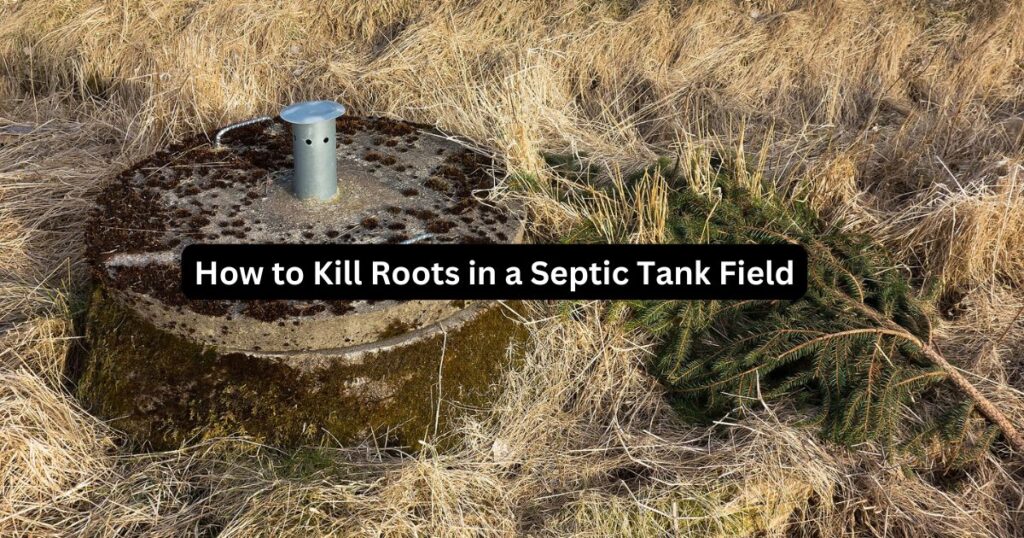To kill roots in a septic tank field, you can use root-killing chemicals like copper sulfate or foaming root killers, remove invasive plants, or hire professionals for mechanical root removal.
Tree roots can damage septic systems, so addressing the issue quickly will help prevent costly repairs.
Identify the Problem
Before taking action, confirm that roots are causing problems in your septic system. Common signs include:
- Slow drains
- Gurgling sounds in pipes
- Sewage backups
- Foul smells near the drain field
If you notice these signs, inspect the area for large trees or plants near the septic system. Tree roots naturally seek water, and your septic system is a prime target. Once you’ve identified the issue, you can start treatment.
5 Ways To Kill Roots In a Septic Tank Field
Use a Root-Killing Chemical
A common method to kill roots is using a root-killing chemical. Copper sulfate and foaming root killers are popular choices.
Copper sulfate works by drying out the roots it comes in contact with. It’s affordable and easy to apply. However, it can take several months to be effective, and it may damage trees near your septic system.
Foaming root killers are another option. They fill pipes and kill roots on contact. The foam allows the chemical to reach higher up in the pipes, where roots tend to grow. Unlike copper sulfate, foaming products act faster.
Follow the product’s instructions carefully when using a chemical treatment. Usually, you’ll flush the product down the toilet, where it can travel to the septic system. Use root killers only as directed, as overuse can harm your septic system’s bacteria balance.
Mechanical Root Removal
If chemicals don’t work or if the root invasion is severe, you may need to remove roots mechanically. This involves using a plumber’s snake with a root-cutting attachment. The snake will cut through the roots blocking the pipes. It’s effective but should only be done by a professional. Incorrect use can damage pipes.
Once roots are cut, follow up with a chemical root killer to prevent regrowth.
Remove Problematic Trees or Plants
Killing the roots is only a temporary fix if trees or plants remain in place. Consider removing trees or large shrubs that are close to your septic system. Trees like willows, maples, and poplars have aggressive roots and should be planted far from your septic field.
If you can’t remove the trees, install a root barrier. Root barriers are physical or chemical barriers placed between the septic system and trees. These barriers block roots from reaching pipes and causing problems.
Use Regular Maintenance
To prevent future root invasions, keep up with regular septic system maintenance. Pump the tank every 3 to 5 years, depending on its size and household usage. Regular pumping removes solid waste and prevents overflows that can attract roots.
Check for leaks in your septic system. Leaky pipes provide a constant water source for roots. Repairing leaks can discourage roots from growing toward the septic field.
Also, limit water use in your home. Excessive water can overload the septic system, leading to soggy soil and encouraging root growth. Spread out laundry loads and fix leaky faucets to avoid overloading the system.
Use Safe Landscaping Practices
When landscaping near your septic system, be mindful of what you plant. Avoid trees and large plants with aggressive roots. Opt for shallow-rooted plants like grasses or perennials, which are less likely to invade your septic system.
Keep a distance of at least 20 feet between trees and your septic field. For larger trees with more extensive root systems, increase the distance to 50 or 100 feet.
Consider using raised beds or container gardening near your septic system. These methods reduce the risk of roots spreading into the septic field.
Avoid Harmful Chemicals
When treating your septic system, avoid using harsh chemicals that can kill beneficial bacteria. Bleach, drain cleaners, and large amounts of household chemicals can harm the system. A balanced septic system relies on bacteria to break down waste. Disrupting this balance can lead to more problems down the line.
Instead, use septic-safe products when cleaning and performing maintenance. These products are designed to work without disrupting the system’s bacteria levels.
When to Call a Professional Plumber
Some septic issues are too complex for DIY solutions. If you’ve tried root-killing chemicals and mechanical removal but still have problems, it’s time to call a professional.
They can inspect your septic system and recommend the best course of action. Regular inspections from a septic professional can also catch root problems early, saving you from costly repairs.
Keep Roots Out of Septic System
Roots in your septic tank field can cause significant damage if not addressed. Using root-killing chemicals, mechanical removal, and proper landscaping can help solve the issue.
Regular septic maintenance and being mindful of what you plant near your system will prevent future problems. If in doubt, don’t hesitate to consult a professional for help.

